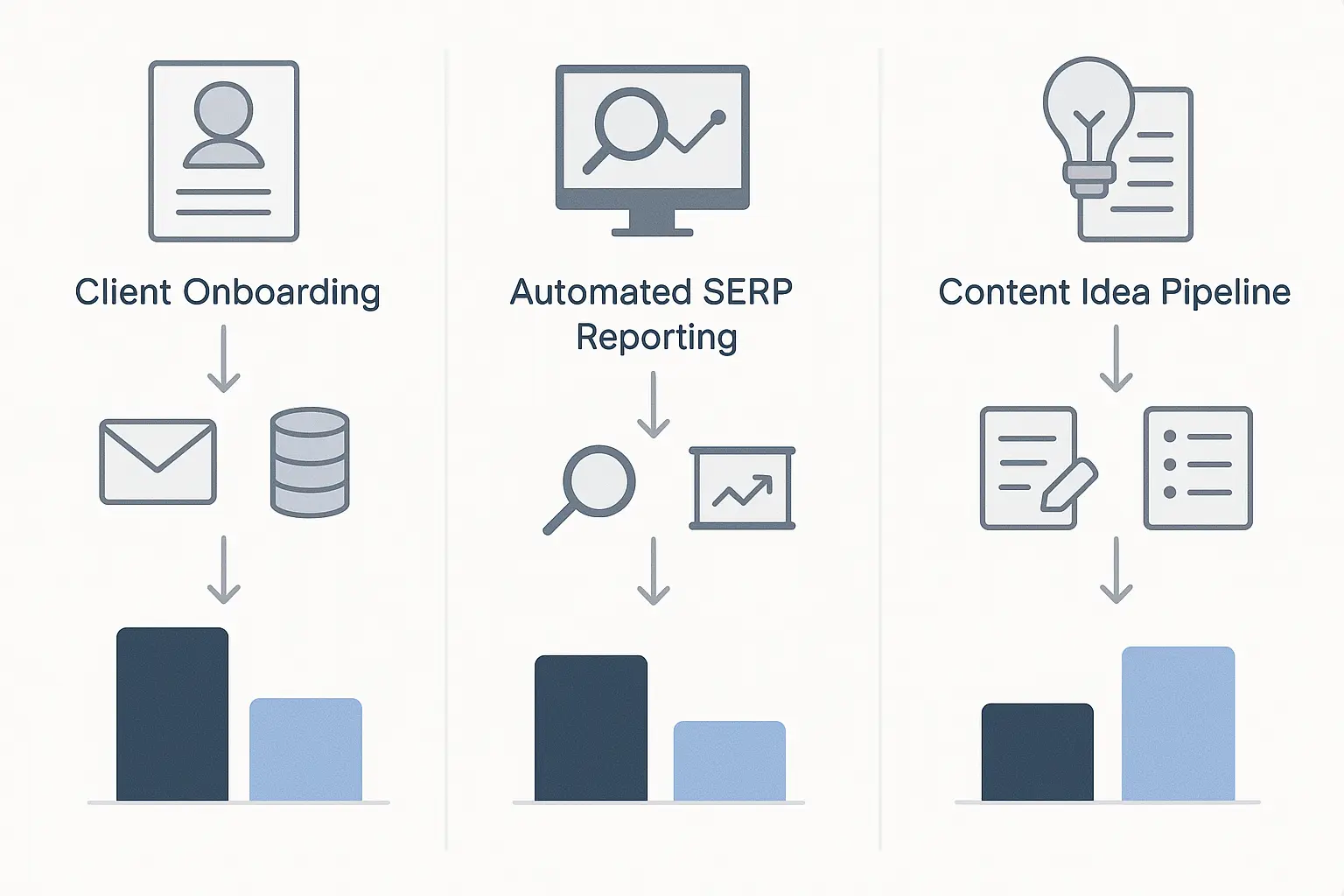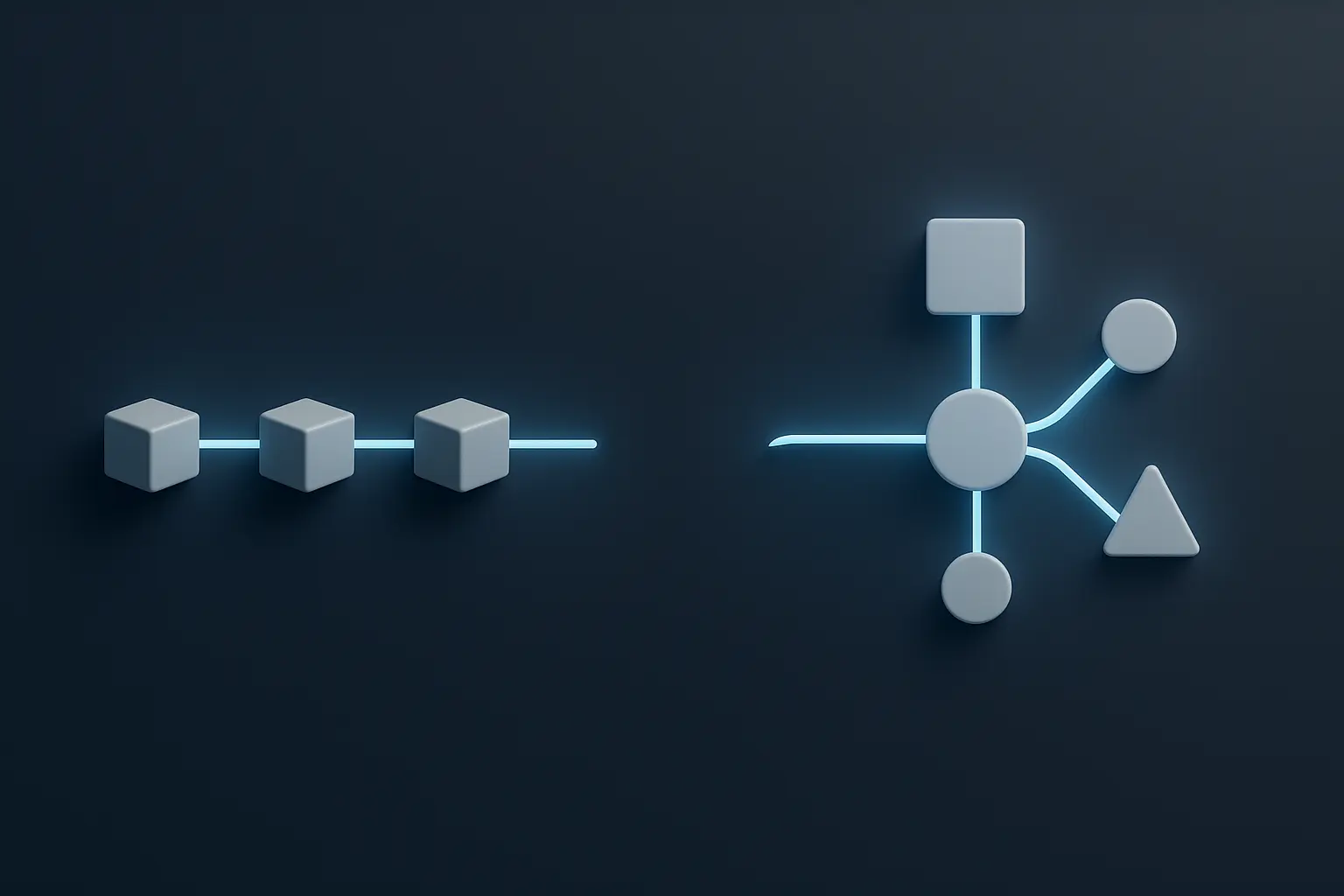It’s 11 PM on a Thursday. Instead of strategizing for your top client, you’re manually copying and pasting keyword data from Ahrefs into a Google Sheet, creating a new task in Asana, and then drafting a notification email in Slack. Sound familiar?
If you’re running a growing SEO agency, you know this feeling all too well. It’s the silent hum of manual, repetitive work that eats away at your most valuable resource: time. Research from Smartsheet found that workers spend, on average, over three hours a day on tasks that could be automated. For an agency, that’s not just lost time—it’s lost profitability, capped growth, and a direct path to burnout.
The solution is automation. But choosing your foundation—the central nervous system of your agency’s operations—often comes down to two heavyweights: Zapier and Make (formerly Integromat). This isn’t just a software choice; it’s a strategic decision that will define how you scale. Let’s break down which platform is the right investment for your agency’s future.
What is No-Code Automation? (And Why Should Your Agency Care?)
Imagine you have a barista (your client onboarding form), a coffee grinder (your project management tool), and an espresso machine (your team’s Slack channel). Without automation, you have to manually carry the beans from one station to the next.
No-code automation platforms like Zapier and Make are the invisible conveyor belts connecting every station. When a new client fills out your form, the “beans” are automatically sent to the grinder to create a new project, which then triggers the espresso machine to notify your team—all without you lifting a finger.
That’s the power of an Integrated Platform as a Service (iPaaS). It’s the secret weapon that, according to a Zapier report, helps 88% of small businesses compete with larger companies. For an SEO agency, this means:
- Consistency: Every client gets the same flawless onboarding experience.
- Efficiency: Your team spends less time on admin and more on high-value strategy.
- Scalability: You can take on more clients without your processes breaking down.

This isn’t just a nice-to-have. In a world where 63% of employees feel they don’t have enough time for their core job duties, automation is the key to unlocking your team’s potential.
The Core Difference: Ease of Use vs. Visual Power
At first glance, Zapier and Make do the same thing: connect your apps. But their approach to how they do it is fundamentally different, and this is where your agency’s needs come into play.
Zapier: The “Get It Done” Champion
Zapier is famous for its simple, linear, “if this, then that” logic. You pick a trigger (like “New Row in Google Sheets”) and then add a series of actions (like “Create a Trello Card,” then “Send a Slack Message”).
Strengths:
- Incredibly User-Friendly: The learning curve is virtually nonexistent. Anyone on your team can build a basic “Zap” in minutes.
- Massive App Library: With over 5,000 app integrations, if there’s a tool you use, Zapier almost certainly connects to it.
- Reliability: It’s the industry standard for a reason—robust and dependable for straightforward workflows.
Best for: Agencies that are new to automation, need to connect a wide variety of apps, and prioritize speed and simplicity for linear tasks.
Make: The Visual Workflow Architect
Make takes a more visual and powerful approach. Instead of a linear list, you get a drag-and-drop canvas where you can build complex “Scenarios.” This allows for advanced logic like branching paths (if a client selects “Package A,” do this; if they select “Package B,” do something else), routers, and error handling.
Strengths:
- Visual Building: Seeing your entire workflow on one canvas makes it easier to understand and debug complex processes.
- Advanced Logic: The ability to add routers, iterators, and aggregators gives you granular control that Zapier can’t easily match.
- Cost-Effective Operations: Its pricing model, which we’ll cover next, can be significantly cheaper for high-volume, multi-step workflows.
Best for: Agencies that need complex, multi-path automations, have some technical comfort, and are focused on optimizing operational costs at scale.

3 Common SEO Agency Workflows: A Practical Comparison
Let’s see how this plays out with real-world agency tasks.
- Client Onboarding: A new client submits a Typeform. You need to create a Google Drive folder, set up a project in Asana, and send a welcome notification in Slack.
- Zapier: Perfect for this. It’s a simple, linear flow (Trigger > Action > Action > Action) that you can set up in 10 minutes.
- Make: Also great, though potentially overkill for this basic version. However, if you wanted to add a router that creates different Asana tasks based on the client’s service package, Make’s visual canvas would handle the logic more elegantly.
- Automated Content Brief Generation: You add a new target keyword to an Airtable base. You want to use the OpenAI API to analyze the top 10 search results, generate a content outline, and create a draft in Google Docs.
- Zapier: Can handle this, but each API call and logic step counts as a separate “Task,” which can get expensive quickly.
- Make: Shines here. You can run multiple API calls, process the data, and use routers—all within a single, more cost-effective “Operation.” The visual flow helps you manage the complexity of data transformation, letting you weave powerful AI in SEO into your process without breaking the bank.
- Monthly Client Reporting: At the end of the month, you want to pull key metrics from Google Analytics, add them to a specific row in a Google Sheet, create a presentation from a Google Slides template, and email the client a link.
- Zapier: Its scheduling trigger is well-suited for this, and the straightforward, step-by-step process is easy to manage.
- Make: Also an excellent choice. Its ability to bundle multiple steps into fewer “Operations” can make this recurring, data-heavy task significantly cheaper to run across dozens of clients.
The Real Cost of Scaling: A Head-to-Head Analysis
The sticker price of these platforms is only part of the story. The real cost-benefit analysis comes down to how they measure usage and how that aligns with your agency’s growth.
Understanding the Lingo: Tasks vs. Operations
This is the most critical difference in their pricing.
- Zapier counts “Tasks.” Every single action your Zap performs is one Task. A Zap with a trigger and four actions uses four Tasks each time it runs.
- Make counts “Operations.” An entire Scenario typically runs for the cost of one Operation, with some exceptions for data-heavy tools. That same workflow with a trigger and four actions would likely use only one Operation in Make.
As you scale the number of clients and the complexity of your workflows, this difference becomes exponential. A five-step onboarding Zap running for 20 clients a month costs 80 Tasks in Zapier. In Make, it’s likely just 20 Operations.

The Hidden Costs of Not Automating
While you’re comparing subscription fees, don’t forget the astronomical cost of manual work.
- Labor Cost: Those three hours per day of manual tasks? For a strategist billing at $100/hour, that’s over $6,000 a month in wasted potential.
- Hiring Cost: A single bad hire can cost an agency over $17,000. Automating repetitive tasks is infinitely cheaper and less risky than hiring another person to do them.
- Opportunity Cost: Every hour your team spends on admin is an hour not spent on client strategy, retention, or new business development. Gartner found that automating lead management alone can boost revenue by 10% in under a year.
The monthly fee for Zapier or Make isn’t an expense; it’s an investment that can reduce marketing overhead by over 12% and is fundamental to how agencies can scale SEO profitably.
The Verdict: Which Tool is Right for Your Agency?
There’s no single right answer, but there is a right answer for you.
Choose Zapier if:
- You’re just beginning your automation journey.
- Your workflows are mostly linear and straightforward.
- You prioritize ease of use and the largest possible app library above all else.
- You need to empower non-technical team members to build their own automations.
Choose Make if:
- You need complex workflows with branching logic, error handling, and multiple paths.
- You’re comfortable with a more visual, technical interface.
- Cost at scale is a primary concern, especially for high-volume tasks.
- You plan to work heavily with APIs and custom data transformation.
Ultimately, your choice of automation platform is a strategic pillar supporting your entire service delivery model. Whether you’re building out an in-house team or scaling your capacity with white-label SEO services, a robust automation engine is the foundation for profitable growth.
Frequently Asked Questions (FAQ)
Can I switch from one to the other later?
Yes, but it requires manually rebuilding every workflow in the new platform. It’s best to choose the platform that aligns with your one- to two-year goals from the start.
Which has better support for core SEO tools like Ahrefs, SEMrush, or Google Search Console?
Both platforms have strong integrations with the major SEO and marketing tools. Zapier’s library is larger, so it may have an edge with more niche or legacy apps, but both cover the essentials exceptionally well.
Is there a steep learning curve for Make?
It’s steeper than Zapier’s, but not insurmountable. If you can understand how functions work in a spreadsheet, you can get the hang of Make. The visual canvas can even make complex workflows easier to debug once you’re used to it.
How does this relate to AI?
These platforms are the “plumbing” that lets you integrate artificial intelligence into your daily operations. You can use them to connect to services like OpenAI’s GPT-4 to automatically enrich data, write content drafts, or summarize reports, turning them into a central hub for your AI in SEO strategy.
Your Next Step: From Automation to Scalable Growth
Choosing between Zapier and Make is a critical first step, but it’s just that—a first step. The real transformation happens when you stop thinking about one-off tasks and start building resilient, scalable systems.
Start small. Pick one repetitive process in your agency this week—client reporting, content briefing, keyword tracking—and map it out on a whiteboard. Identify the manual touchpoints. This simple audit is your first move toward reclaiming thousands of hours and building an agency that can grow without breaking.

